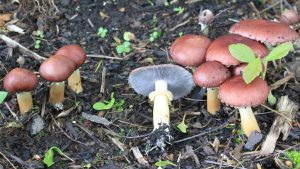#055: The Old Man of the Woods, Strobilomyces floccopus
This bolete is easily distinguished by the prominent tufts of black “hair” that cover the otherwise greyish cap and stipe. Despite the old man imagery, floccopus is probably one of the most beautiful mushrooms. It at least deserves to be counted among the best dressed mushrooms due to its showy scales. The scales are the most striking feature of the Old Man of the Woods. They are soft, black, and wooly, which makes them stand out from the whitish to grayish pileus. The wooly fibers are long and often hang over the edge of the convex pileus, giving the mushroom an unkempt appearance. On top of that, the cap’s margin often sports the remnants of a whitish to grayish partial veil. The stipe is similarly covered with dense, black fibers, which obscure the whitish to grayish color of the stipe surface. When you flip the mushroom over, you will notice that spore surface underneath the cap is covered in pores. S. floccopus is, in fact, a bolete. This is evidenced by its pores, its central stipe, and its terrestrial habitat (see FFF#028 for more on boletes). The pores of the Old Man of the Woods are small (1-3 per millimeter) and angular (with flat sides, rather than circular). Initially, the pore surface is white, but it becomes gray to black with age. Another notable feature of this mushroom is its bruising reaction. When cut or bruised, the whitish flesh first turns pinkish or reddish and then slowly darkens to black. The spore print of S. floccopus is black to blackish brown. Under the microscope, you can see that the spores are decorated with lines called reticulation that make them look like wrinkled peas. Like most other boletes, the Old Man of the Woods is mycorrhizal with hardwoods. You can find this medium-sized mushroom fruiting in summer and fall on the ground around hardwoods, especially oaks. This mushroom grows in Eastern North America, but is occasionally sighted in the southwest. S. floccopus is listed as edible, but it apparently does not have a very good flavor.
Earlier I said that this mushroom is easily distinguished. That may not be completely true. Recently (2012), the three accepted European species were found to be just one species: Strobilomyces strobilaceus. However, the same study demonstrated that S. strobilaceus was not found in North America. No work has been done on American Strobilomyces phylogeny since then, so its nomenclature is currently in limbo. There are currently two Strobilomyces species described in North America: S. floccopus and S. confusus. The hairy scales on S. confusus are shorter and straighter than those of S. floccopus. There is also another name floating around: S. dryophilus. However, this name has not been officially described by a mycologist and is therefore not accepted. S. dryophilus is characterized by a pinkish cap underneath its hairy scales. In North America, the common name “Old Man of the Woods” refers to S. floccopus, but might as well be used for any of the American Strobilomyces, given the current taxonomic uncertainty. The genus Strobilomyces is placed in the phylum Basidiomycota, class Agaricomycetes, order Boletales, and family Boletaceae.
Here are a couple other interesting points about its name. First of all, Strobilomyces means pinecone-like mushroom. The species name floccopus refers to its wooly texture. Up until the 1960’s, field guides used that translation of the Latin name as the common name for S. floccopus (for example, “Pine Cone Mushroom”). Apparently the common name “Old Man of the Woods” is a fairly recent development. If you’d all like to try your hand at creating a common name for a mushroom, then I suggest “Cruella de Vil Mushroom” for S. confusus, providing it is still considered a separate species from S. floccopus. I think this name would suit S. confusus because its scales are smaller and neater (more spot-like).
See Further:
http://www.mushroomexpert.com/strobilomyces_floccopus.html
http://www.morelmushroomhunting.com/strobilomyces__floccopus.htm (pictures)
http://www.mushroomexpert.com/strobilomyces.html
http://mdc.mo.gov/discover-nature/field-guide/old-man-woods
http://www.rogersmushrooms.com/gallery/DisplayBlock~bid~6786.asp







![#011: Characteristics of Kingdom Fungi [Archived]](https://www.fungusfactfriday.com/wp-content/themes/hueman/assets/front/img/thumb-small-empty.png)


1 Response
[…] and stipe and also contains the universal veil [1]. It’s pileus has the width of 50-160 mm. It is convex, scaly, dry and dull [1] . Stipe is up to 14 cm long and 2 cm thick. The context of the mushroom is fleshy, soft and […]